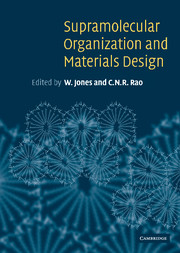Book contents
- Frontmatter
- Contents
- List of contributors
- Preface
- 1 Assembly and mineralization processes in biomineralization: strategies for forming biological composite materials
- 2 Mesoscale materials synthesis and beyond
- 3 Towards the rational design of zeolite frameworks
- 4 Mesoscale self-assembly: the assembly of micron-and millimeter-sized objects using capillary forces
- 5 Design of amphiphiles for the modulation of catalytic, membranous and gelation properties
- 6 Nanofabrication by the surface sol-gel process and molecular imprinting
- 7 The hierarchy of open-framework structures in metal phosphates and oxalates
- 8 Mesoscale self-assembly of metal nanocrystals into ordered arrays and giant clusters
- 9 Layered double hydroxides as templates for the formation of supramolecular structures
- 10 Molecular machines
- 11 Some aspects of supramolecular design of organic materials
- 12 Controlling crystal architecure in molecular solids: the supramolecular approach
- Index
9 - Layered double hydroxides as templates for the formation of supramolecular structures
Published online by Cambridge University Press: 18 December 2009
- Frontmatter
- Contents
- List of contributors
- Preface
- 1 Assembly and mineralization processes in biomineralization: strategies for forming biological composite materials
- 2 Mesoscale materials synthesis and beyond
- 3 Towards the rational design of zeolite frameworks
- 4 Mesoscale self-assembly: the assembly of micron-and millimeter-sized objects using capillary forces
- 5 Design of amphiphiles for the modulation of catalytic, membranous and gelation properties
- 6 Nanofabrication by the surface sol-gel process and molecular imprinting
- 7 The hierarchy of open-framework structures in metal phosphates and oxalates
- 8 Mesoscale self-assembly of metal nanocrystals into ordered arrays and giant clusters
- 9 Layered double hydroxides as templates for the formation of supramolecular structures
- 10 Molecular machines
- 11 Some aspects of supramolecular design of organic materials
- 12 Controlling crystal architecure in molecular solids: the supramolecular approach
- Index
Summary
Introduction
A key feature of the chemistry of layered materials is the location of molecules (guests) of interest within the relatively constrained region of the interlayer. As such, the incorporation of guest molecules into layered hosts affords a versatile approach towards obtaining novel nanocomposite materials. Once intercalated, the guests can demonstrate interesting physical and chemical properties. Numerous types of layered solids have therefore been studied, including clay minerals, graphite, transition metal dichalcogenides, and metal phosphates and phosphonates [1–3]. By appropriate choice of the host and guest, novel hybrid materials can be created, exhibiting enhanced properties compared with the two individual components [4]. An ideal property of the host matrix would be the ability to control the number, orientation and location of guests that can be incorporated.
Layered double hydroxides (LDHs), also known as anionic clays and hydrotalcite-like materials, are layered solids that are of increasing interest [5–8]. They consist of stacks of positively charged hydroxide layers with interlayer, charge-balancing, anions and are available as naturally occurring minerals [9] and as synthetic materials. They were prepared in the laboratory in 1942 when Feitknecht reacted dilute aqueous metal salt solutions with base [10, 11], although the first detailed structural analyses of LDHs were not performed until the late 1960s by Allmann and Taylor and their co-workers [12–15].
- Type
- Chapter
- Information
- Supramolecular Organization and Materials Design , pp. 295 - 331Publisher: Cambridge University PressPrint publication year: 2001
- 5
- Cited by



